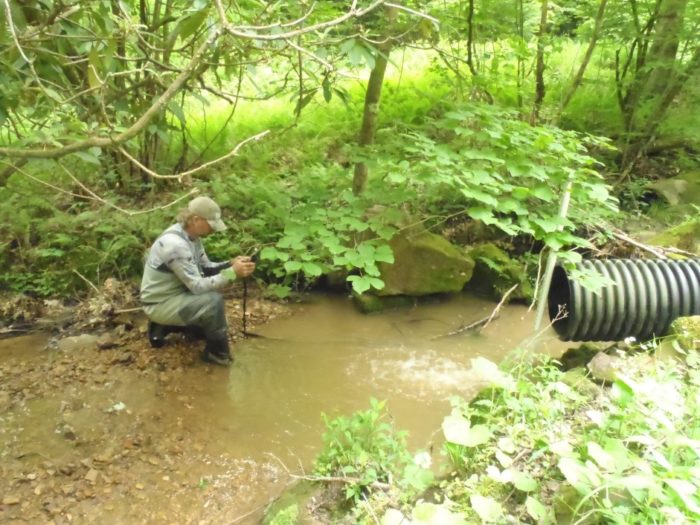Pittsburgh, Pa. – April 30, 2020 – The Western Pennsylvania Conservancy’s watershed conservation program staff, located in Indiana, Pa., will begin to assess road-stream intersections for aquatic organism passage (AOP) potential in Clearfield County beginning in spring 2020.
WPC received a planning grant from the Coldwater Heritage Partnership (CHP) to conduct the surveys, which will focus on streams that have known crossings that contain naturally reproducing brook trout populations according to data from the Pennsylvania Fish and Boat Commission. Bridges and culverts will be assessed using the North Atlantic Aquatic Connectivity Collaborative (NAACC) protocol that all fish passage projects are evaluated with in Pennsylvania. CHP provides two grant opportunities that help to protect and conserve the health of Pennsylvania’s cold-water ecosystems.
This methodology allows for structures to be ranked for AOP potential and decisions can be made as to which structures should be replaced for the greatest upstream habitat reconnection for native species. Once all of the crossing surveys are complete, WPC’s scientists and specialists will recommend in a completed plan which structures should be replaced in Clearfield County based on field observations.
“We want people in Clearfield County to understand why WPC staff are out there walking around in the streams. Local communities previously provided input for Cold Water Conservation Plans written for Lick Run, Lower Clearfield Creek and Upper Moshannon Creek. Continued work in these watersheds will help local road managers prioritize road culvert improvements and replacements,” said Eric Chapman, director of aquatic science for WPC.
For more information about this effort, contact our watershed conservation program office at 724-471-7202 or water@paconserve.org.

Barriers such as culverts and dams block fish migration, degrade water quality and alter fish and other aquatic habitats in local rivers and streams. Pictured here, WPC Director of Aquatic Science Eric Chapman is measuring the outlet drop of a perched culvert. His research will help determine which structures should be replaced or removed to help reconnect the stream, which will ultimately improve spawning habitat for native species.
###
About the Western Pennsylvania Conservancy:
The Western Pennsylvania Conservancy (WPC) enhances the region by protecting and restoring exceptional places. A private nonprofit conservation organization founded in 1932, WPC has helped to establish 11 state parks, conserved more than a quarter million acres of natural lands and protected or restored more than 3,000 miles of rivers and streams. The Conservancy owns and operates Frank Lloyd Wright’s Fallingwater, now on the UNESCO World Heritage List, which symbolizes people living in harmony with nature. In addition, WPC enriches our region’s cities and towns through 132 community gardens and other green spaces that are planted with the help of more than 11,000 volunteers. The work of WPC is accomplished through the support of more than 9,000 members. For more information, visit WaterLandLife.org or Fallingwater.org.
Media Contact:
Carmen Bray
Director of Communications
412-586-2358
cbray@paconserve.org
